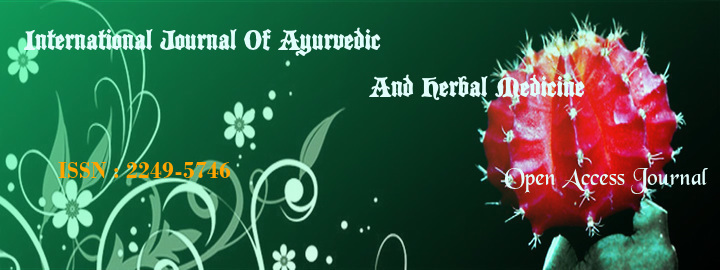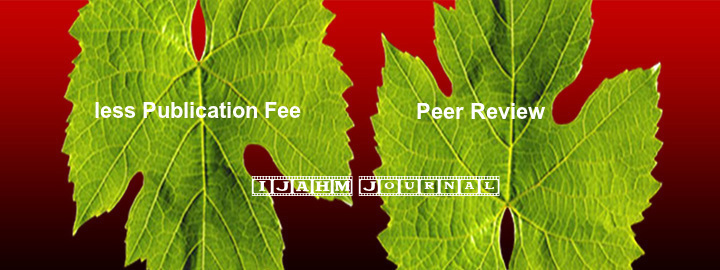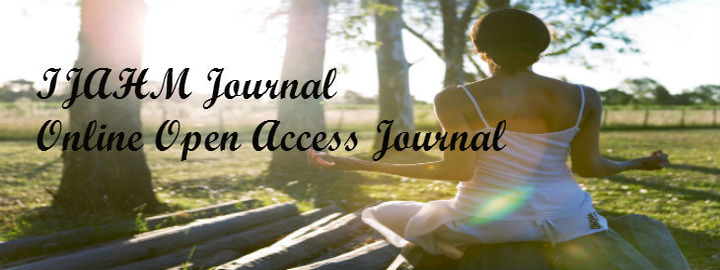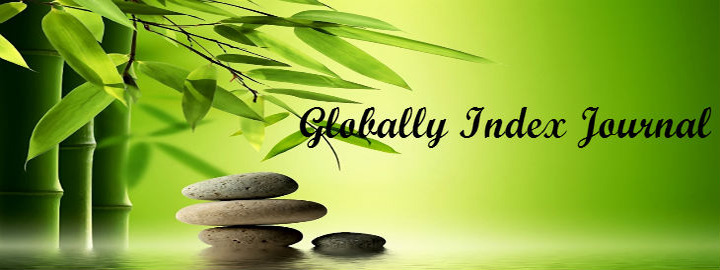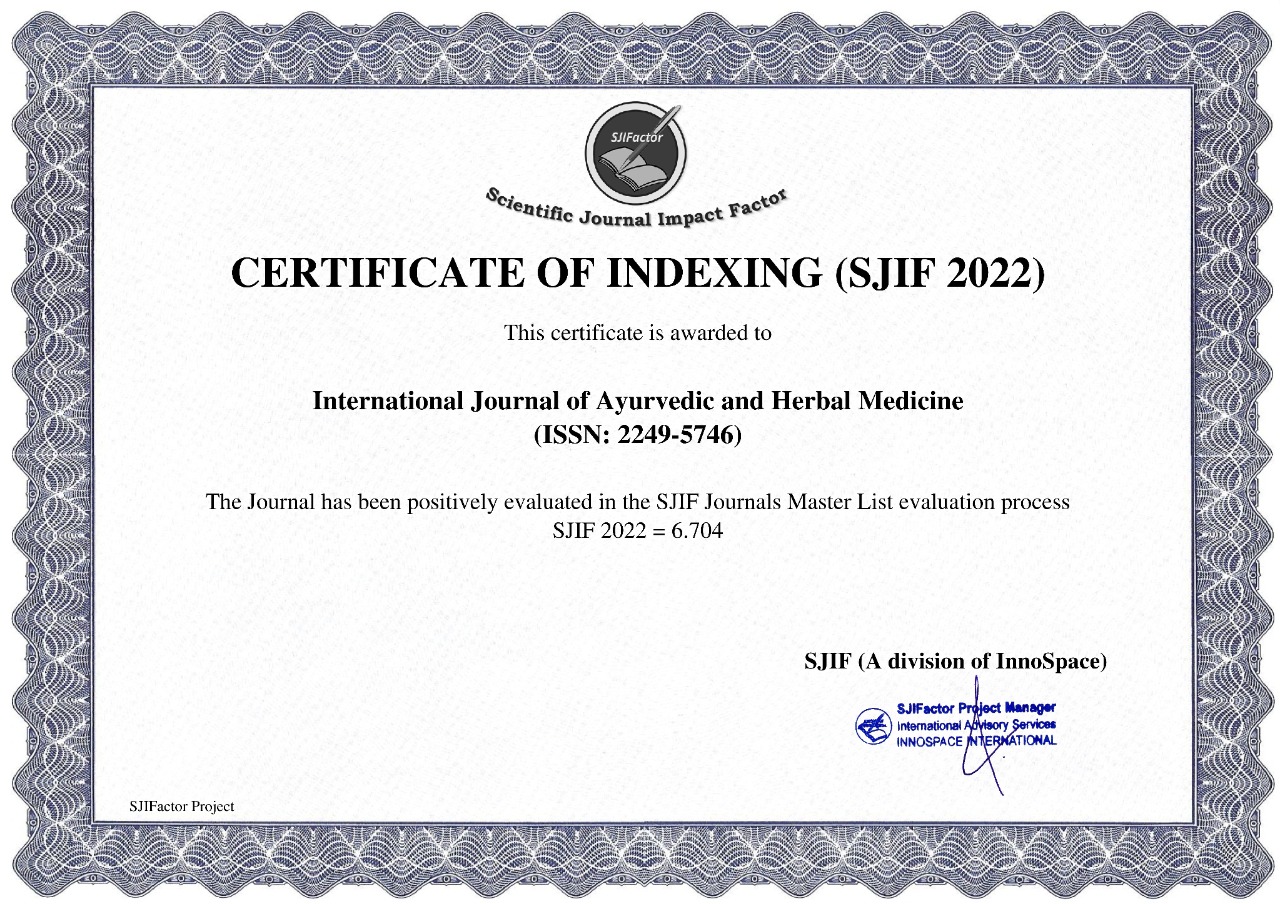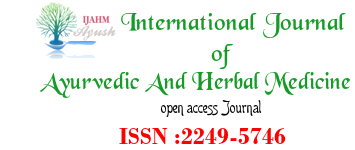


Elkhalifa, Mofida, Y.1, Baballa, Khalid, M.2
1,2Medicinal and Aromatic Plants and Traditional Medicine Research Institute. National Center for Research, Khartoum State, Sudan
DOI : http://dx.doi.org/10.47191/ijahm/v14i5.05
ABSTRACT:
Traditional medicine (TM) remains a cornerstone of healthcare in Sudan, across urban and rural settings. We explored TM use and its association with socio-demographic characteristics (age, sex, education, economic status, and residence) in East Nile locality (ShargAlneil), Khartoum State. A survey encompassing 609 households (44.7% rural, 55.3% urban) revealed a high prevalence of TM use: over 80% reported using at least one form. Notably, significant socio-demographic variations emerged. Individuals with higher education leaned towards herbalists (p<0.05), while those with lower education favored religious healers (p<0.05). Similarly, older adults preferred religious healers (p<0.05), while males tended to choose herbalists (p<0.05).
The most common ailments preferred to be treated by TM practitioners were spiritual and psychological issues, bone injuries, stomachaches, and headaches. Conversely, conditions like malaria, diabetes, hypertension, and heart disease were primarily preferred to be managed by modern medicine.
This study highlights the widespread use of TM across diverse demographics, with preferences for specific types of practitioners. It also underscores a selective trust in modern medicine for certain diseases. Integrating socio-demographic and cultural perspectives into healthcare delivery can enhance understanding of community needs and guide the development of appropriate interventions. Further research is warranted to delve deeper into the reasons behind these variations in treatment preferences.
KEYWORDS: traditional healing, alternative medicine, socio-economic and healthcare delivery, Africa.
REERENCES:
- Moeti M. African Traditional Medicine Day 2022. Message of WHO Regional Director for Africa. World Health Organization, African Region. 31 August 2022.
- Alsafi A. Traditional Sudanese Medicine. Azza Press. Cairo. 2006, 379-381.
- Ensink K and Robertson B. Patient and family experiences of psychiatric services and African indigenous healers. Transcultural Psychiatry1999; 36(1):23–43.
- Elkhalifa M. Women and income generating activities and conservation of natural resources: Medicinal, culinary and aromatic plants in the Sudan. SD dimensions: people, gender and development. A document of the FAO Regional Office, 2003.
- Yagi S and Yagi A. (2021). Important medicinal plants-Sudan. In Medicinal and Aromatic Plants of the World. Encyclopedia of Life Support Systems (EOLSS), Eolss Publishers. 2021, pp20.
- Salah M, Adam I and Malik E. Care-seeking behavior for fever in children under five years in an urban area in Eastern Sudan. Journal of Family and Community Medicine 2007; 14(1):25-28.
- Ahmed O and Martin H. Barriers leading to treatment default among tuberculosis patients in Khartoum State, Sudan: a qualitative study. Clin. Med. Invest. 2018; 3(1):1-8.
- Ali B and Mahfouz M. Herbal Medicine Use among Patients with Type2 Diabetes in North Sudan. Annual Research and Review in Biology 2014; 4(11):1827-1838.
- Eltayeb S, Abdalla S, Van den Bergha G and Heuch I. Use of healthcare services by injured people in Khartoum State, Sudan. Int Health 2015; 7:183–189.
- Idris S, Mohammed O and Basheer E. Why do people prefer traditional bonesetters in Sudan? Sudan JMS 2010; 5(3):199-205.
- Ahmed B, Ahmed I. Siddiq F, Muhamadi K and Aljezooli MH. Self-care remedies used to relieve dental pain among Sudanese in Khartoum State, Sudan. International Journal of Dental Sciences and Research 2017; 5(4):88-92.
- Koriana E. Experience of patients and carers with traditional healing and psychiatric services, and the outcome of psychosis for patients who attend traditional services in Sudan. Ph. D. Thesis. Department of Psychological Medicine, Faculty of Medicine, University of Malaya. Kuala Lumpur, 2013, 199-204.
- Sudan Federal Ministry of Health. The Annual Health Statistical Report. The Sudan Federal Ministry of Health, The National Information Center. Khartoum, 2018. 8.
- Satti S, Mohamed-Omer S, and Hajabubker M. Pattern and determinants of use of traditional treatments in children attending Gaafar Ibnauf Children’s Hospital, Sudan. Sudanese Journal of Paediatrics 2016; 16(2):45-50.
- Malik E, Hanafi K, Ali S, Ahmed ES and Mohamed KA. Treatment-seeking behavior for malaria in children under five years of age: implication for home management in rural areas with high seasonal transmission in Sudan. Malaria Journal 2006; 5:60.
- Comoro C, Nsimba S E, Warsame M and Tomson G. Local understanding, perception and reported practices of mothers/guardians and health workers on childhood malaria in Tanzania district- implications for malaria control. Acta Trop 2003; 87:305-313.
- WHO-AIMS Report. Mental Health System in Sudan, WHO and Ministry of Health, Khartoum, 2009, 10-12.
- Sorketti EA, Zainal N Z, and Habil,MH. The characteristics of people with mental illness who are under treatment in traditional healer centres in Sudan. International Journal of Social Psychiatry 2012; 58(2):204-216.
- Osman AH, Bakhiet A, Elmusharaf S, Omer A and Abdelrahman A. Sudan's mental health service: challenges and future horizons. BJPsych. International 2020; 17(1):17-19.
- Alsafi A. Traditional Sudanese Medicine. Azza Press. Cairo. 2006, 390-391.
- Sudan Federal Ministry of Health. The Annual Health Statistical Report. The Sudan Federal Ministry of Health, The National Information Center. Khartoum, 2018. 26.
- Card, E.; Obbayemi, J.; Shirima O. lazaro M, Massawe H, Stanifer JW and et al. Practices and Perspectives of traditional bone Setters in Northern Tanzania. Ann. Glob. Health 2020; 86(1):61,1-8.
- Lauche R, Cramer H, Hohmann C, Choi K, Rapp T, Saha FJ and et al. The effect of traditional cupping on pain and mechanical thresholds in patients with chronic nonspecific neck pain: A randomized controlled pilot study. Evidence-Based Complementary and Alternative Medicine 2012; (1): 29718.
- Farhadi K, Schwebe, DC, Saeb M, Choubsaz M, Mohammadi R and Ahmadi A. The Effectiveness of wet-cupping for nonspecific low back pain in Iran: A randomized controlled trial. Complementary Therapies in Medicine 2008; 17: 9-15.
- Ahmadi A, Schwebel DC and Rezaei M. The Efficacy of Wet-Cupping in the Treatment of Tension and Migraine Headache. American Journal of Chinese Medicine 2008; 36:37-44.
- Alsafi A. Traditional Sudanese Medicine. Azza Press. Cairo. 2006, 141-145.
- AbdelRahim SI. Zar culture and psychopathology. Current Psychiatry 1999; 6(2):167-181.
- Baballa KM. Knowledge and attitudes of medical doctors towards traditional medicine practices. A case study at three teaching Hospitals in Khartoum State. Ph. D. Dissertation, Sudan Academy of Sciences 2018, 40-48.
- Ahmed G, Ahmed E, Ahmed A, Hammeda L, Birier AB, Abdelgadir T and et al. Prevalence and reasons to seek traditional healing methods among residents of two localities in North Kordofan State, Sudan 2022: A cross‐sectional study. Health Sci. Rep. 2023; 6:1-8.
- Baasher T. The healing power of faith. The Magazine of the World Health Organization 1982; mental health:5-8.
- Mohammed I and Babikir H. Traditional and Spiritual medicine among Sudanese children with epilepsy. Sudan J. Paediatr 2013; 13(1):31-37.
- Sudan Federal Ministry of Health. The Annual Health Statistical Report. The Sudan Federal Ministry of Health, The National Information Center. Khartoum, 2018. 55-69.
- Elolemy A and Abdullah A. Public Knowledge, attitude and practice of complementary and alternative medicine in Riyadh Region, Saudi Arabia. Oman Med J. 2012; 27(1): 20–26.
- Mahgoub AT, Elmedani KA, Abdalla WM and Elkhalifa MY. The influence of socioeconomic status of mothers on attending traditional healers in Khartoum State. Journal of Human and Social Science Research 2014; 2(2):57-65.
- Calixto JB. The role of natural products in modern drug discovery. An Acad Bras Cienc 2019; 91(Suppl 3):e20190105.
- Elghazali G,Elegami A, Mohammed G, Abdalla WE and Mohamed H. Poisonous Plants of Sudan. National Centre for Research, Ministry of Science and Technology, Khartoum, 2008.
- Abdelmagid A. An inside look at traditional medicine in Sudan, 500words Magazine 2018 Oct.; 7.
- Ernst E. Harmless herbs? A review of the recent literature. Am J Med 1998; 104:170–8.
- Wassie S, Aragie L, Taye Band Mekonnen L. Knowledge, attitude, and utilization of traditional medicine among the communities of Merawi Town, Northwest Ethiopia: A cross-sectional study. Evid. Based Complement. Alternat. Med. 2015; 138073.
- Habtom G. and Ruys P. The choice of a health care provider in Eritrea. Health Policy 2007; 80(1):202-17.
- Stekelenburg J, Jager B, Kolk P, Westen EHM, van der Kwak A and Wolffers IN. Health care seeking behavior and utilization of traditional healers in Kalabo, Zambia. Health Policy 2005; 71(1):67-81.
- Kendall EM. A short history of the training of midwives in the Sudan. Sudan Notes and Records 1953; 33(1):42-53.
index







